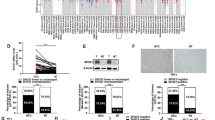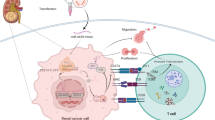Abstract
Altered microRNA expression is associated with tumor proliferation, metastasis, and tumorigenesis. In this study, we studied the role of miR-3117 in hepatocellular carcinoma (HCC) cell proliferation and found that miR-3117 was upregulated in HCC tissues and cells. MTT assay, soft agar growth assay, BrdU assay, and cell cycle assay revealed that miR-3117 overexpression promoted HCC HepG2 cell proliferation and that knockdown of miR-3117 suppressed HepG2 proliferation. Mechanism analysis suggested PH domain and leucine-rich repeat protein phosphatase-like (PHLPPL) as the target of miR-3117. Luciferase reporter assay suggested that miR-3117 directly binds to the 3′UTR of PHLPPL. Double knockdown of miR-3117 and PHLPPL copied the phenotypes caused by miR-3117 overexpression, suggesting that miR-3117 contributes to the proliferation of HepG2 by targeting PHLPPL. Our study provided a target for HCC therapy.





Similar content being viewed by others
References
Torre LA, Bray F, Siegel RL, Ferlay J, Lortet-Tieulent J, Jemal A (2015) Global cancer statistics, 2012. CA Cancer J Clin 65(2):87–108. doi:10.3322/caac.21262
Testino G, Leone S, Borro P (2014) Alcohol and hepatocellular carcinoma: a review and a point of view. World J Gastroenterol 20(43):15943–15954. doi:10.3748/wjg.v20.i43.15943
Pezzuto F, Izzo F, Buonaguro L, Annunziata C, Tatangelo F, Botti G, Buonaguro FM, Tornesello ML (2016) Tumor specific mutations in TERT promoter and CTNNB1 gene in hepatitis B and hepatitis C related hepatocellular carcinoma. Oncotarget. doi:10.18632/oncotarget.9801
Cheng S, Yang J, Shen F, Zhou W, Wang Y, Cong W, Yang GS, Cheng H, Hu H, Gao C, Guo J, Li A, Meng Y, Jiang X, Yang Y, Qian G, Luo M, Hu B, Man X, Zhang B, Su C, Zhou F, Li N, Shi J, Wang M, Zheng Y, Guo W, Sun J, Wang H, Lau WY, Wu MC (2016) Multidisciplinary management of hepatocellular carcinoma with portal vein tumor thrombus—Eastern Hepatobiliary Surgical Hospital consensus statement. Oncotarget. doi:10.18632/oncotarget.8386
Harding JJ, Abou-Alfa GK (2014) Treating advanced hepatocellular carcinoma: how to get out of first gear. Cancer 120(20):3122–3130. doi:10.1002/cncr.28850
Bartel DP (2004) MicroRNAs: genomics, biogenesis, mechanism, and function. Cell 116(2):281–297
Ma Y, Liang AJ, Fan YP, Huang YR, Zhao XM, Sun Y, Chen XF (2016) Dysregulation and functional roles of miR-183-96-182 cluster in cancer cell proliferation, invasion and metastasis. Oncotarget. doi:10.18632/oncotarget.8715
Zhang W, Liu K, Liu S, Ji B, Wang Y, Liu Y (2015) MicroRNA-133a functions as a tumor suppressor by targeting IGF-1R in hepatocellular carcinoma. Tumour Biol 36(12):9779–9788. doi:10.1007/s13277-015-3749-8
Neerincx M, Sie DL, van de Wiel MA, van Grieken NC, Burggraaf JD, Dekker H, Eijk PP, Ylstra B, Verhoef C, Meijer GA, Buffart TE, Verheul HM (2015) MiR expression profiles of paired primary colorectal cancer and metastases by next-generation sequencing. Oncogenesis 4:e170. doi:10.1038/oncsis.2015.29
Wang YQ, Ren YF, Song YJ, Xue YF, Zhang XJ, Cao ST, Deng ZJ, Wu J, Chen L, Li G, Shi KQ, Chen YP, Ren H, Huang AL, Tang KF (2014) MicroRNA-581 promotes hepatitis B virus surface antigen expression by targeting Dicer and EDEM1. Carcinogenesis 35(9):2127–2133. doi:10.1093/carcin/bgu128
Qiao M, Wang Y, Xu X, Lu J, Dong Y, Tao W, Stein J, Stein GS, Iglehart JD, Shi Q, Pardee AB (2010) Mst1 is an interacting protein that mediates PHLPPs’ induced apoptosis. Mol Cell 38(4):512–523. doi:10.1016/j.molcel.2010.03.017
Brognard J, Niederst M, Reyes G, Warfel N, Newton AC (2009) Common polymorphism in the phosphatase PHLPP2 results in reduced regulation of Akt and protein kinase C. J Biol Chem 284(22):15215–15223. doi:10.1074/jbc.M901468200
Liao WT, Li TT, Wang ZG, Wang SY, He MR, Ye YP, Qi L, Cui YM, Wu P, Jiao HL, Zhang C, Xie YJ, Wang JX, Ding YQ (2013) microRNA-224 promotes cell proliferation and tumor growth in human colorectal cancer by repressing PHLPP1 and PHLPP2. Clin Cancer Res 19(17):4662–4672. doi:10.1158/1078-0432.CCR-13-0244
He X, Zhang Z, Li M, Li S, Ren L, Zhu H, Xiao B, Shi R (2015) Expression and role of oncogenic miRNA-224 in esophageal squamous cell carcinoma. BMC Cancer 15:575. doi:10.1186/s12885-015-1581-6
Mei Z, He Y, Feng J, Shi J, Du Y, Qian L, Huang Q, Jie Z (2014) MicroRNA-141 promotes the proliferation of non-small cell lung cancer cells by regulating expression of PHLPP1 and PHLPP2. FEBS Lett 588(17):3055–3061. doi:10.1016/j.febslet.2014.06.020
Cai J, Fang L, Huang Y, Li R, Yuan J, Yang Y, Zhu X, Chen B, Wu J, Li M (2013) miR-205 targets PTEN and PHLPP2 to augment AKT signaling and drive malignant phenotypes in non-small cell lung cancer. Cancer Res 73(17):5402–5415. doi:10.1158/0008-5472.CAN-13-0297
Mao XP, Zhang LS, Huang B, Zhou SY, Liao J, Chen LW, Qiu SP, Chen JX (2015) Mir-135a enhances cellular proliferation through post-transcriptionally regulating PHLPP2 and FOXO1 in human bladder cancer. J Transl Med 13:86. doi:10.1186/s12967-015-0438-8
Chen X, Hao B, Han G, Liu Y, Dai D, Li Y, Wu X, Zhou X, Yue Z, Wang L, Cao Y, Liu J (2015) miR-372 regulates glioma cell proliferation and invasion by directly targeting PHLPP2. J Cell Biochem 116(2):225–232. doi:10.1002/jcb.24949
Agarwal NK, Zhu X, Gagea M, White CL 3rd, Cote G, Georgescu MM (2014) PHLPP2 suppresses the NF-kappaB pathway by inactivating IKKbeta kinase. Oncotarget 5(3):815–823. doi:10.18632/oncotarget.1774
Brognard J, Sierecki E, Gao T, Newton AC (2007) PHLPP and a second isoform, PHLPP2, differentially attenuate the amplitude of Akt signaling by regulating distinct Akt isoforms. Mol Cell 25(6):917–931. doi:10.1016/j.molcel.2007.02.017
Luedde T, Schwabe RF (2011) NF-kappaB in the liver–linking injury, fibrosis and hepatocellular carcinoma. Nature Rev Gastroenterol Hepatol 8(2):108–118. doi:10.1038/nrgastro.2010.213
Bao C, Li Y, Huan L, Zhang Y, Zhao F, Wang Q, Liang L, Ding J, Liu L, Chen T, Li J, Yao M, Huang S, He X (2015) NF-kappaB signaling relieves negative regulation by miR-194 in hepatocellular carcinoma by suppressing the transcription factor HNF-1alpha. Sci Signal 8:387. doi:10.1126/scisignal.aaa8441
Zhang PF, Li KS, Shen YH, Gao PT, Dong ZR, Cai JB, Zhang C, Huang XY, Tian MX, Hu ZQ, Gao DM, Fan J, Ke AW, Shi GM (2016) Galectin-1 induces hepatocellular carcinoma EMT and sorafenib resistance by activating FAK/PI3 K/AKT signaling. Cell Death Dis 7:e2201. doi:10.1038/cddis.2015.324
Wang Q, Yu WN, Chen X, Peng XD, Jeon SM, Birnbaum MJ, Guzman G, Hay N (2016) Spontaneous hepatocellular carcinoma after the combined deletion of akt isoforms. Cancer Cell 29(4):523–535. doi:10.1016/j.ccell.2016.02.008
Author information
Authors and Affiliations
Corresponding author
Ethics declarations
Conflicts of interest
The authors declare that they have no competing interests.
Additional information
Xia Cui and Qingyan Li contributed equally to this work.
Rights and permissions
About this article
Cite this article
Cui, X., Li, Q. & He, Y. miR-3117 regulates hepatocellular carcinoma cell proliferation by targeting PHLPPL. Mol Cell Biochem 424, 195–201 (2017). https://doi.org/10.1007/s11010-016-2855-2
Received:
Accepted:
Published:
Issue Date:
DOI: https://doi.org/10.1007/s11010-016-2855-2




